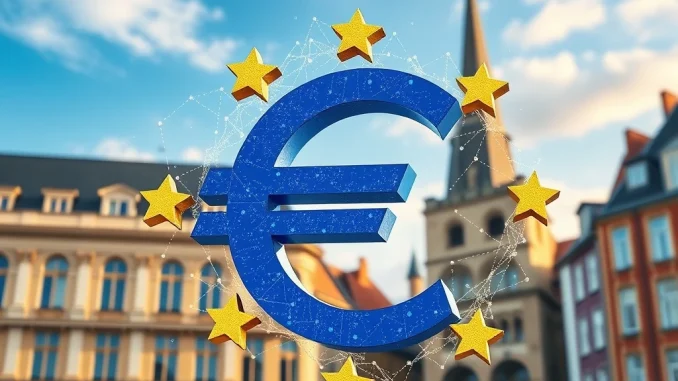
A powerful call to action has emerged from a prominent figure in European finance. Lorenzo Bini Smaghi, currently the chairman of French banking giant Societe Generale and a former member of the European Central Bank’s (ECB) Executive Board, has strongly advocated for Europe to overcome its caution and actively embrace Europe stablecoins. His argument, detailed in an opinion piece for the Financial Times, highlights a critical juncture for the continent’s future in the evolving digital financial landscape.
Why Europe Must Act Now on Stablecoins
Bini Smaghi’s core message is stark: Europe risks being sidelined in the burgeoning digital financial ecosystem if it doesn’t change its stance on stablecoins. He points out a significant imbalance in the current market:
- Globally, approximately 99% of stablecoins in circulation are denominated in U.S. dollars.
- In stark contrast, there is minimal adoption or use of Euro stablecoins.
This disparity suggests that while the digital finance revolution is well underway, Europe is currently a spectator rather than a key player, particularly when it comes to stablecoins – digital currencies designed to maintain a stable value, often pegged to a fiat currency like the Euro or Dollar.
MiCA and the Paradox of European Regulation
Europe has made significant strides in regulating the crypto space with the implementation of the Markets in Crypto-Assets Regulation (MiCA). Bini Smaghi acknowledges this, stating that Europe possesses the world’s most comprehensive framework for cryptocurrencies. However, he identifies a paradox: despite having clear rules, Europe’s inherent risk aversion is hindering innovation and adoption.
The presence of a robust framework like MiCA stablecoins provides regulatory clarity that is lacking in many other jurisdictions. MiCA specifically addresses stablecoins, categorizing them and setting requirements for issuers regarding authorization, governance, reserve assets, and consumer protection. This should, in theory, pave the way for legitimate stablecoin activities within the EU. Yet, according to Bini Smaghi, the potential is not being realized because caution prevails over opportunity.
European Banks and the Hesitation Hurdle
A significant part of the challenge lies with traditional financial institutions. Many European banks crypto involvement remains limited and hesitant. Bini Smaghi asserts that these banks still perceive stablecoins as inherently risky. Their concerns often revolve around issues like:
- Potential impacts on financial stability.
- Anti-Money Laundering (AML) and Counter-Terrorist Financing (CTF) compliance complexities.
- Lack of clear investment incentives compared to traditional asset classes.
- Uncertainty about the business models associated with stablecoins.
This cautious approach from major financial players is a significant barrier to the widespread adoption and issuance of Euro-denominated stablecoins, further solidifying the dominance of USD stablecoins.
Securing Europe’s Digital Finance Future
Embracing stablecoins is not just about keeping up; it’s about securing Europe’s place in the future of global finance. A thriving ecosystem of Euro stablecoins could offer numerous benefits:
- Enhanced Competitiveness: Allows European businesses and individuals to participate directly and efficiently in the global digital economy.
- Payment Innovation: Facilitates faster, cheaper, and more accessible cross-border and domestic payments.
- Monetary Sovereignty: Reduces reliance on foreign-denominated digital assets and infrastructure, ensuring the Euro remains relevant in the digital age.
- New Business Models: Opens doors for decentralized finance (DeFi) applications and other blockchain-based innovations built on a stable, Euro-denominated foundation.
Ignoring this potential means ceding ground to other currencies and regions, potentially leaving Europe dependent on foreign digital financial infrastructure.
Overcoming Risk Aversion: A Path Forward
Bini Smaghi’s intervention serves as a wake-up call. For Europe to truly leverage its comprehensive MiCA stablecoins framework and foster a vibrant Digital finance Europe, several steps are necessary:
- Encourage Euro Stablecoin Issuance: Actively promote and incentivize the creation of high-quality, well-regulated Euro stablecoins by European entities, including banks and fintech firms.
- Educate and Engage Banks: Work with European banks crypto concerns, providing clearer guidance and demonstrating the potential benefits and viable business models within the MiCA framework.
- Promote Global Use of Euro Stablecoins: Position Euro stablecoins as a reliable and attractive option for international transactions and digital applications.
- Continuous Regulatory Adaptation: While MiCA is strong, regulators must remain agile and willing to adapt as the technology and market evolve.
The choice, as highlighted by Bini Smaghi, is clear: Europe can remain cautious and fall behind, or it can leverage its regulatory strengths and financial expertise to embrace stablecoins and secure its role in the future of Digital finance Europe.
Summary: The Time for Embrace is Now
Lorenzo Bini Smaghi’s compelling argument underscores the urgency for Europe to pivot from caution to embrace regarding stablecoins. Despite possessing the robust MiCA framework, risk aversion, particularly within the banking sector, is preventing the widespread adoption of Euro stablecoins, leaving Europe vulnerable to being excluded from the rapidly expanding digital financial ecosystem dominated by the US dollar. To ensure its future competitiveness and monetary sovereignty, Europe must actively encourage the issuance and use of Euro stablecoins, engage its financial institutions, and fully capitalize on the regulatory clarity provided by MiCA. The window of opportunity is open, but acting decisively is essential to unlock Europe’s potential in digital finance.



